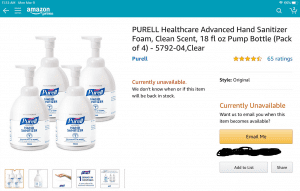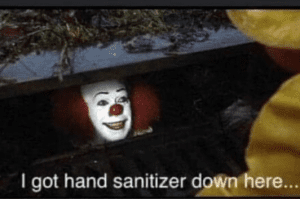Lately, it seems like everyone has a story, or a picture posted on their social media account of the cobwebs and a “LIMIT: 2” sign inhabiting the store shelves where hand sanitizer, disinfectant spray or wipes, or toilet paper used to live. After leaving the store empty-handed, maybe you thought you’d try your luck ordering the goods online…

…or not…
Maybe you could get lucky to find some hand sanitizer online, but the prices were jacked sky high — leading you to a decision of “nah, I’ll pass.”
So, what’s happened here? Aside from a fraction of people deciding that a 55 gallon drum’s worth of sanitizer is the only acceptable quantity to possess, the answer is pretty simple: prices have failed to react – or more accurately – have not been allowed to react to the changing circumstances.
With the rising concerns about the spread of the coronavirus, we are seeing heightened consumer demand for goods that get rid of germs. More people want more disinfectants than usual – even for the standard cold/flu/allergy season. However, suppliers, distributors, and merchants all have not had the time to adjust their plans to the changing conditions.
In a purely theoretical scenario — when there’s tight supply and heightened demand in a given market, prices rise. In other words, the efficient solution for the sanitizer shortage is for the price of it to rise. Had this been allowed to happen, this would have discouraged people from rolling out of their local stores with carts full of sanitizer, wipes, and sprays. Instead, people would have purchased an appropriate amount of disinfectant for their situation. Younger and healthier folks would have merely topped off their supplies, or chosen another cleaning method altogether. This, in turn, would leave more supply for individuals who are older and/or may have some sort of more serious health concern and need a higher level of cleanliness in their environment.
These rising prices wouldn’t simply serve an allocation function in the stores. They also give producers, and suppliers, incentive to get their product to the areas where there is the greatest need. The suppliers who are most agile in redirecting disinfectants to the places where the prices are the highest have the potential to earn the most money for efficient provision of their services.
Unfortunately, price gouging laws muffle the signals provided by prices. The failure for prices to rise leads to an increased likelihood that relatively young and healthy folks can raid the shelves and effectively hoard the disinfectant supplies. If the stores are being thoughtful, and complying with the law in light of these drastic increases to disinfectant demand, that’s when we see the “LIMIT: 2” signs. But those quota signs are more of a response to rapidly depleting shelves than a preemptive move.
But more importantly, and potentially more tragically, the muffled price signals from price gouging laws mean there are muffled incentives for suppliers and distributors to react to the new conditions. In light of what’s become a pandemic situation, there’s only so much mileage that goodwill and altruism can eke out in ensuring appropriate levels of supplies.
Be prepared. Avoid panicking. Wash your hands.

And don’t trust any sewer clowns offering you sanitizer.
Jessi Troyan, Ph.D. is the Development Director for the Cardinal Institute for West Virginia Policy.












